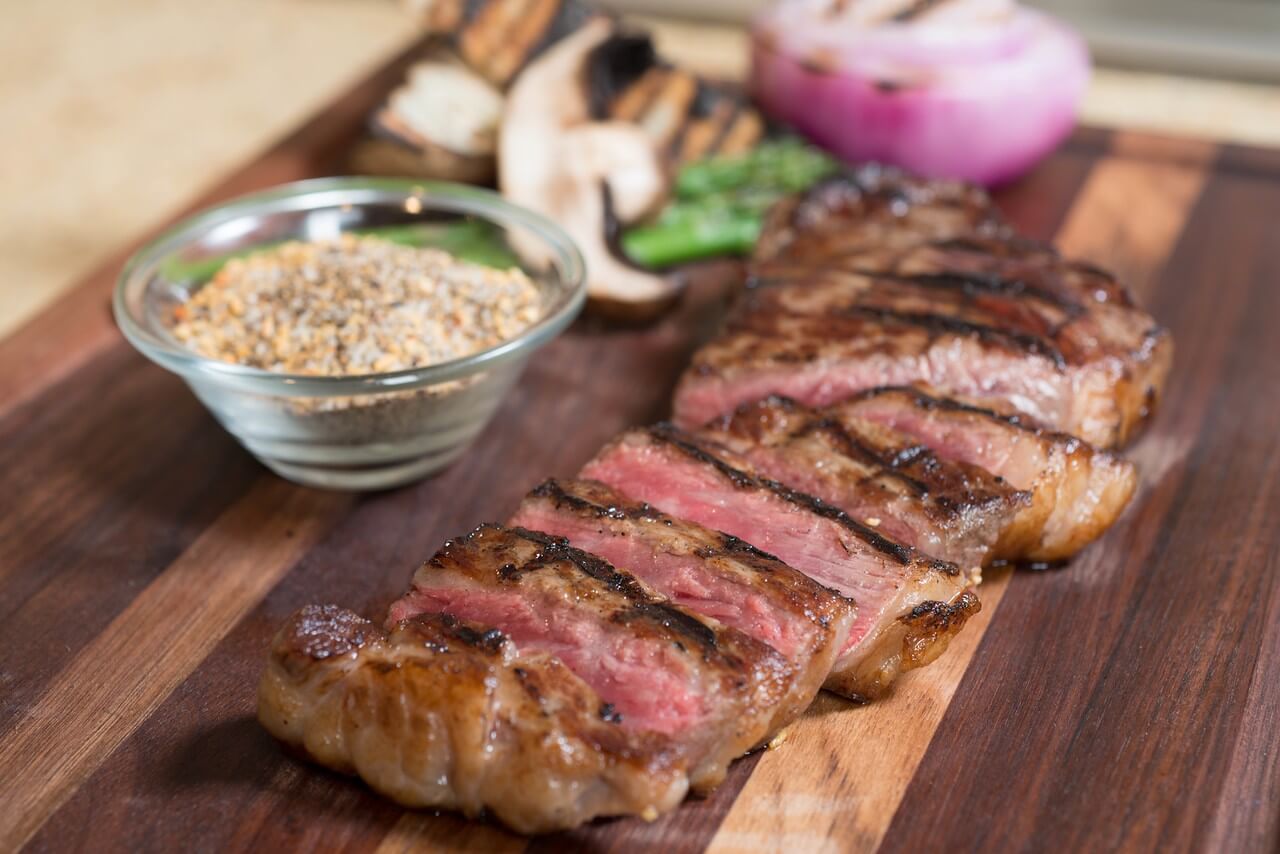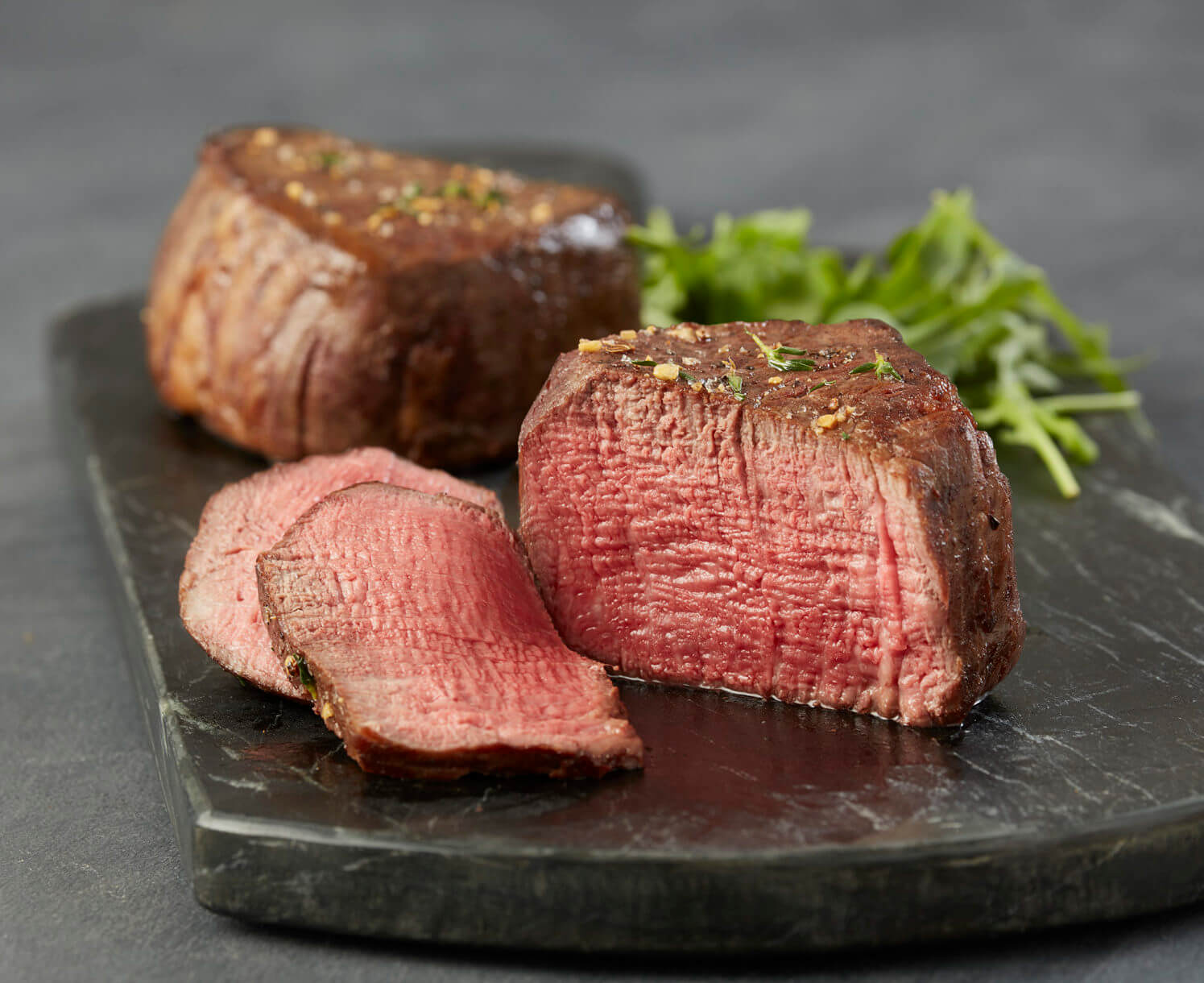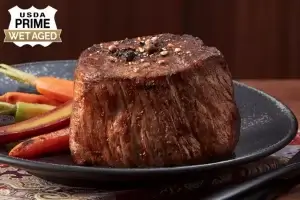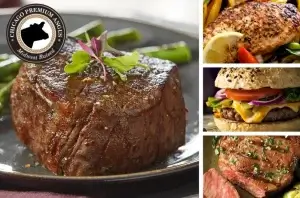
It’s a well-known adage, handed down from meat lovers from generations past, that “A good steak is cooked to no more than medium rare.” In fact, you might even consider a medium rare steak the perfect steak. While some steak enthusiasts out there may be nodding their heads in silent approval of this sage advice, those among us without a degree in “proper meat doneness” from the “University of Beef” may be wondering just what it means when someone advises cooking steaks to medium rare. Never fear, this Steak University feature will delve into the mysteries of a medium-rare steak and have you grilling like an expert in no time.
Table of Contents
Just What is Medium Rare Anyways?
“Medium rare” is a shorthand term used to describe the degree of doneness of a cut of beef. While the broad definition is fine and dandy, calling a steak cut medium-rare doesn’t convey much without a few key points of reference. Heat wise, the temperature of a medium-rare steak cut will reach a maximum of 130-140 degrees Fahrenheit. Visually, a medium-rare steak will have a medium pink to red center and will be warm to the touch. Contrary to popular belief, the cut will not be red meat, undercooked meat, or raw meat, but rather, have a light pink center that’s safe to eat.
The benefits of cooking medium-rare steaks are numerous. The temperature of a medium-rare steak is just hot enough to allow the marbling, or fat, to melt into the meat and distribute flavor and juiciness. Cook steak to medium or well-done, and you’ll most likely get a tough piece of meat that will give your jaw muscles a workout. Cook a steak less than medium-rare, and the fat doesn’t have the same opportunity to distribute; not to mention, you will also be jamming a hunk of cold squishy beef in your mouth.
Is a Medium Rare Steak Safe to Eat?
A lot of people get concerned about seeing pink in their steak. Doesn’t that mean it’s not fully cooked? Won’t bacteria grow in there? Unfortunately, medium-rare often gets confused with rare steak, which has an easily identifiable red color. It’s important to know that medium rare steak is not the same as raw steak or rare meat. A medium rare rib eye won’t hurt you if it’s a quality piece of meat that’s cooked properly and stored safely before and after it’s cooked.
Medium rare steak gets cooked to a safe temperature. You usually stop cooking it between 135 and 140 degrees and then allow it to sit and rest for a few minutes. During this time, its temperature continues to rise slightly because the heat keeps it cooking. When all is said and done, your medium-rare steak should be at 145 degrees, which is considered safe to eat.
How to Check for Medium-Rare Doneness
Now that you are armed with the what and why of a medium-rare perfectly cooked steak, it’s time to talk application. If you don’t know how to check the level of doneness of a steak, you might end up with a medium cooked or a medium well steak, despite your best intentions of cooking a steak to medium-rare.
Because cutting into a steak while cooking to assess the appearance of its insides will allow juices to escape and leave you with something resembling steak tartare, we recommend checking doneness in other ways to preserve your steak’s texture and flavor. When it comes to knowing how to cook steak or grill a steak medium-rare, there are a few tried and true techniques to choose from.
Method #1: Time It
One of the oldest and least complicated methods when it comes to understanding how to grill a steak to medium-rare is the standby timing method. Usually, 3-5 minutes per side on a hot grill or pan will ensure your steaks are medium-rare and juicy. The problem with this technique is that not all grills, pans, oven, or steaks, for that matter, are uniform, so steak cooking times can vary significantly.
A grill that’s just 20 degrees too hot, or a pan that’s been left in the oven just a few minutes too long, or even an irregular or thicker cut of meat, can be the difference between cooking a medium-rare steak and cooking a well-done steak. The 3-5-minute guidelines will apply to a pre-heated grill or pan and for steaks that are about 1” thick. Thinner steaks will need less time, thicker steaks more, to reach the perfect, drool-worthy temperature of a medium-rare steak.
Method #2: The Handy Meat Thermometer
What the timing method lacks in precision, the modern meat thermometer makes up for with technological accuracy. Cooking a medium-rare steak to the perfect temperature has never been easier, whether you’re charcoal grilling, searing and then baking, using the reverse sear method, or cooking steak a different way.
Simply insert the thermometer probe into the center of the meat, make sure it is in the medium-rare temperature threshold of 130-140 degrees Fahrenheit, and voila! Your delicious and perfectly cooked steak is ready to be served! But, there are some drawbacks to determining doneness with a thermometer, no matter how advanced.
For starters, inserting a probe thermometer requires you to pierce the meat, creating an escape path for vital juices. Additionally, depending on your cooking method, inserting a thermometer may be inconvenient in tighter spaces, or require you to place the cooking instrument in the direct path of fire or high heat, which can be a hazardous risk. Modern thermometers have infra-red technology that measures surface temperature, eliminating both of these issues. However, it’s not nearly as handy for determining the internal temperature of a medium-rare steak.
Method #3: The Expert Level “Touch” Technique
The final technique when it comes to grilling the perfect steak to medium-rare perfection can require a bit of trial and error. In the long run, however, mastering the “touch” technique to steak doneness can not only create a perfect medium-rare cut every time, but it also looks pretty darn impressive to friends and family.
When it comes to execution, a medium-rare steak will have some squish or give when lightly pressed on with your finger. If a steak is rare, it will be all squish and will hold an indent from where it’s been pressed. A medium steak, or one cooked even longer, won’t give at all, or only minimally. It may take some time, trial and error to perfect the “touch” method, but we’ve found this is undoubtedly the best for ensuring the perfect level of medium rare doneness time in and out.
You can use this method as you cook steak to gauge doneness. First, hold your hand up and touch the tip of your middle finger to your thumb. With your other hand, poke the fleshy part of your palm underneath the thumb. What you feel is how your steak should feel for medium-rare. (Tip: For comparison, touch the tips of your other fingers to your thumbs, too. The firmer the fleshy part feels, the more it resembles a higher level of doneness, like medium or medium well.)
After you’re done searing steak, hold the steak with a pair of tongs. Then, poke the thickest part of the meat with one finger. Does it feel like the fleshy part of your palm did in your test? If so, your steak should be medium rare!
The Wrap Up
Steak University has given you the tools to medium rare success. Now it’s your turn to go out and put these skills to good use with Chicago Steak Company’s 5-star steakhouse quality steaks. Don’t worry, like proud parents, Steak University will always be here to serve as your handy dandy reference to grilled steak perfection.

Simple Medium Rare Steak Recipe
Grilled Medium Rare Steak
INGREDIENTS
|
INSTRUCTIONS
- Sprinkle each side of steak with Chicago Steak Company Seasoning and Worcestershire sauce
- Fire up the grill to high heat
- Grill steaks for 3-4 minutes per side (based on 1″ thick steaks)
- Use a meat thermometer to ensure internal temperature is between 130-140 degrees Fahrenheit (Keep in mind the inside of the steak will continue to cook a bit longer once it is removed from the grill)
- Remove steaks from grill and let sit for 3-5 minutes and enjoy!
See below for more information about temperatures and cook time based on the thickness of your sirloins.
Top Sirloin Steaks Cooking Chart
| Thickness | Rare 110° To 120° F | Medium Rare 120° To 130° F | Medium 130° To 140° F |
|---|---|---|---|
| 1″ | 5 min First Side 3 min Second Side |
4.5 min EACH SIDE | 6 min First Side 4 min Second Side |
| 1.25″ | 5 min First Side 4 min Second Side |
5.5 min EACH SIDE | 7 min First Side 5 min Second Side |
| 1.5″ | 6 min First Side 4 min Second Side |
6 min EACH SIDE | 7 min EACH SIDE |
| 1.75″ | 6 min First Side 5 min Second Side |
6.5 min EACH SIDE | 8 min First Side 7 min Second Side |
| 2″ | 6 min EACH SIDE | 7 min EACH SIDE | 8 min EACH SIDE |
Cooking Medium Rare FAQs
A Chicago Steak Company Sirloin cooked to Medium Rare Perfection “Medium rare” is a term that describes a steak cooked to a temperature of 130-140 degrees Fahrenheit. The temperature of a medium-rare steak is just hot enough to allow the marbling, or fat, to melt into the meat and distribute flavor and juiciness. Now, how do you produce that medium-rare steak? We have 3 methods. Method #1: Time It 3-5 minutes per side on a hot grill or pan will ensure your steaks are medium-rare and juicy. Keep in mind that this technique may be tricky since not all grills, pans, oven, or steaks for that matter, are uniform. The 3-5-minute guidelines will apply to a pre-heated grill or pan and to steaks that are about 1” thick. Thinner steaks will need less time, thicker steaks more. Method #2: The Handy Meat Thermometer Simply insert the thermometer probe into the center of the meat, make sure it is in the medium-rare temperature threshold of 130-140 degrees Fahrenheit, and voila: your medium-rare steak is ready to be served! Method #3: The Expert Level “Touch” Technique The final technique when it comes to grilling a steak to medium-rare perfection can require a bit of trial and error. When it comes to execution, a medium-rare steak will have some squish, or give, when lightly pressed on with your finger. If a steak is rare it will be all squish and will hold an indent from where it’s been pressed. A medium steak, or one cooked even longer, won’t give at all, or only minimally.



